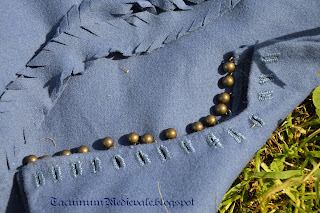380r, Latin 757 Missale et horae ad usum Fratrum Minorum, Bibliothèque nationale de France.
Ho realizzato un cappuccio destinato ad essere abbinato all'abito verde che al momento utilizzo per rappresentare Damisella Gonzaga.
Pur avendo tenuto come riferimento il modello Norlund 78 - D10606, ho apportato qualche modifica alla forma: ho reso la foggia leggermente più grande, per coprire completamente la scollatura del vestito una volta indossato, l'ho reso più aderente intorno al viso e ho aggiunto 14 bottoni di metallo per renderlo più ricco e adatto ad essere abbinato all'abito signorile. La lana che ho utilizzato è in tessitura piana abbastanza compatta, caratteristica che la rende adatta ad essere tagliata a frappe in quanto tende a non sfilacciarsi.
Le particolarità di questo cappuccio sono due:
1. La coda, becchetto o liripipium, è frastagliata: ho cercato di riprodurre il più fedelmente possibile, nell'intaglio e nella proporzione rispetto al corpo e alle mani, la miniatura che ho preso come riferimento. La fonte, tra l'altro, è la stessa che ho utilizzato per la terzolla. Esempi di code affrappate sono presente in numerose fonti iconografiche e documentarie del periodo.
2. La coda è attaccata al cappuccio tramite uno spillo: ho ripreso questo dettaglio da una novella del Trecentonovelle di Sacchetti (Novella CXXXVII), che racconta di come una donna fiorentina abbia usato questo escamotage per non essere multata per il possesso del cappuccio con il becchetto affrappato, evidentemente vietato dalle norme suntuarie della città.
E' si truova una donna col becchetto frastagliato avvolto sopra il cappuccio; il notaio mio dice: "Datemi il nome vostro; però che avete il becchetto intagliato"; la buona donna piglia questo becchetto che è appiccato al cappuccio con uno spillo, e recaselo in mano, e dice ch'egli è una ghirlanda.
In the past few months, I had a lot of things to do (some of them were re-enactment related, of course) and I had very little time for the blog: so, I would like to take some time to share my last - very small - project.
I made a hood that will be used together with the green dress I am wearing - at this time - to portray Damisella Gonzaga.
I used as a reference the model Norlund 78 - D10606, but I made a few changes to the shape: I made the shoulder part bigger to be able to cover the neckline, I made it more tight-fitting around the face and I added 14 metal buttons to make it richer. The wool I used is tabby-woven and quite strong, a feature that makes it suitable to be dagged, as it doesn't fray,
This hood has 2 special features:
1. The liripipe is dagged: I tried to reproduce as close as possible the source, considering both the shape of the dagges and the proportions to the hands and body of the lady - the source, by the way, is the same I chose for the terzolla. There are many examples of dagged liripipes both in visual and documentary sources of the time.
2. The liripipe is attached to the hood with a pin: I took this detail from a tale by Sacchetti (Trecentonovelle, tale number 137), that tells the story of a Florentine woman who used this trick not to pay a fee for wearing a hood with a dagged liripipe, that must have been forbidden according to the sumptuary laws of the city.
"And he found a woman with a dagged liripipe wrapped around the hood: and the notary says: "Give me your name, as you have a dagged liripipe"; and the good woman takes the liripipe, that is attached to the hood with a pin, and takes it in her hand, and says it's a garland".






